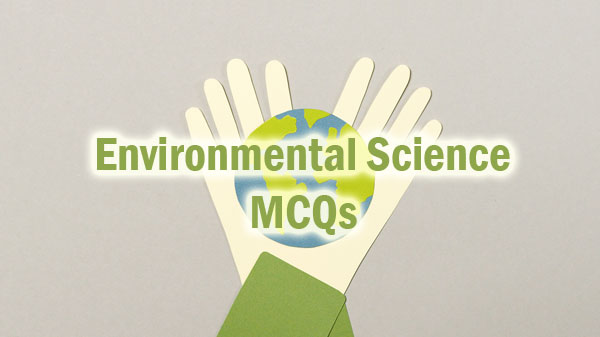Environmental Studies Objective Question
Download all Environmental Studies Objective Question Papers here. We are providing Environment Science Objective Question Papers. We have given the solutions for EVS solved Objective Question Papers to make your preparation efficient.

Click here to Download the Environment Science Objective Question Papers from the attached pdfs. EVS Objective Question Papers attached in the PDF Format so the aspirants can download quickly. Along with these Environmental Studies Objective Question papers, we have attached Environment Science Syllabus and Exam Pattern.
Environmental Studies Objective Question Papers are available. Applicants can download EVS Objective Question Papers. Also, get the Study material, Preparation tips in addition to the EVS Objective Question Papers for posts. On our page, we provide Environmental Studies Objective Question Papers for the sake of aspirants.
Objective Question on Environmental Studies
1. Ozone layer is found in the :
(A) Ionosphere
(B) Troposphere
(C) Mesosphere
(D) Stratosphere
2. The value of environmental lapse rate is :
(A) ~10°C per km
(B) ~6°C per km
(C) ~1°C per km
(D) ~4°C per km
3. The unit of pressure ‘hPa’ commonly used in meteorology is equal to :
(A) 1 dyne/cm2
(B) 1 dyne/m2
(C) 100 dyne/m2
(D) 1000 dyne/cm2
4. Tropopause is at its highest level at :
(A) Poles
(B) Equator
(C) Subtropics
(D) Mid-latitude
5. How many agreements are there in Agenda 21 ?
(A) 2
(B) 5
(C) 6
(D) 7
6. Darwin’s finches are a good example of :
(A) Convergent evolution
(B) Industrial mentalism
(C) Connecting link
(D) Adaptive radiation
7. The oldest macrofossils of plants and animals are only ……………… years old and if these were the remains of the original living organisms, the planet would have been lifeless for almost ……………….. years.
(A) 0.6-0.7; 4.0 billion
(B) 0.5-0.6; 3.0 billion
(C) 0.4-0.5; 2.0 billion
(D) 0.3-0.4; 1.0 billion
8. Which of the following air pollutant(s) is (are) mainly responsible for poor air quality at most of the Indian sites ?
(A) Carbon soot
(B) Atmospheric dust
(C) Carbon soot + atmospheric dust
(D) CO2
9. Which of the following is a must for rice sheath blight pathogen, Pellicularia sasakii ?
(A) Polyoxin D
(B) Polyoxin B
(C) Polyoxin L
(D) Polyoxin
10. Acetylene reduction technique is an important assay to measure :
(A) Rate of phosphate solubilization
(B) Rate of Nitrogen fixation
(C) Rate of Carbon fixation
(D) Rate of photosynthesis
11. The most preferred technique for the analysis of metals is :
(A) Ion chromatography
(B) Atomic absorption spectroscopy
(C) Mass spectrometry
(D) Titrimetry
12. A radioactive sample shows an activity of 40,000 cpm. What will be its activity after four half lives ?
(A) 10,000
(B) 4,000
(C) 2,500
(D) 2,000
13. As compared to the aridified regions of the globe, rain water in India has an excess of :
(A) Chloride
(B) Calcium
(C) Sodium
(D) Methyl sulphonic acid
14. Which of the following is correct order with respect to solubility product ?
(A) AgI < AgBr < AgCl
(B) AgI > AgBr > AgCl
(C) AgI < AgCl < AgBr
(D) AgI > AgCl > AgBr
15. Which of the following consists of only one element ?
(A) Sand
(B) Marble
(C) Glass
(D) Diamond
16. Carrying capacity is :
(A) prevention of population explosion
(B) the maximum number of organisms that a habitat can sustain
(C) the limiting factors existing in an ecosystem
(D) the upper limit of J curve
17. Which one of the following is an abiotic component of the ecosystem ?
(A) Bacteria
(B) Plants
(C) Fungi
(D) Humus
18. The total biomass of any organism is determined by the nutrients present in the minimum concentration in relation to the requirements of that organism, known as :
(A) Liebig’s law of the minimum
(B) Shelford’s law of tolerance
(C) Liebig’s law of tolerance
(D) Shelford’s law of minimum
19. The source of energy for the green plants in any ecosystem is :
(A) Glucose
(B) Sunlight
(C) ATP
(D) Protein
20. The largest number of species on earth belongs to :
(A) Fungi
(B) Angiosperms
(C) Insects
(D) Crustaceans
21. The commonly used medium for submerged bacterial fermentation at commercial scale is :
(A) Molasses
(B) Liver extract
(C) Germinated seed
(D) Peptone
22. An ecosystem is a complex of interacting systems of :
(A) Individuals
(B) Populations
(C) Communities and their soils
(D) Biotic and abiotic components
23. GIS and remote sensing are very useful to analyse :
(A) Quality of life
(B) Spatio-temporal data
(C) Behavioral pattern of flora and fauna
(D) Sound-economic data
24. The earth’s atmosphere is divided into layers based on the vertical profile of :
(A) Air pressure
(B) Air temperature
(C) Air density
(D) Wind speed and direction
25. ……………………….. Planet in the solar system is also known as a Blue Planet.
(A) Venus
(B) Jupiter
(C) Earth
(D) Mars
26. Which one of the following is an example for assessing Land quality ?
(A) Fauna
(B) Sulfur
(C) Slope
(D) Community
27. Vegetation cover has maximum reflectance level in which one of the following electromagnetic radiation spectrum ?
(A) Middle infrared
(B) Visible
(C) Near infrared
(D) Ultraviolet
28. What are the major weather related hazards during winter ?
(A) Floods
(B) Fog and coldwave
(C) Tropical cyclones
(D) Dust storms
29. Salinity of sea water depends upon evaporation and precipitation difference. Thus it is highest near :
(A) Poles
(B) Equator
(C) Subtropics
(D) Mid-latitudes
30. GIS is an efficient tool for :
(A) analysing spatial and aspatial data
(B) analysing attribute data only
(C) manipulating behaviour of flora and fauna
(D) assessing ecological pyramids
31. CO2 emissions from the burning of fossil fuel affect largely :
(A) Sulphur cycle
(B) Nitrogen cycle
(C) Carbon cycle
(D) Water cycle
32. The rich source of energy that never causes atmospheric pollution is :
(A) Nuclear energy
(B) Solar energy
(C) Fossil fuel
(D) Biomass energy
33. A photovoltaic cell is not limited in efficiency by :
(A) top surface emissivity
(B) quantum efficiency
(C) excess photon energy
(D) top surface reflection
34. Gasohol used to run the vehicles is a mixture of :
(A) Petrol and Diesel
(B) Petrol and Methane
(C) Petrol and Alcohol
(D) Petrol and Kerosene
35. Greenhouse gases usually comprise :
(A) CO2 only
(B) CH4 only
(C) CH4, CO2 mainly and NOx slightly
(D) CH4 and CO2 only
36. The optimum range of wind speed for generating energy with windmills is :
(A) 5 to 30 km/hr
(B) 5 to 20 km/sec
(C) 0 to 10 km/sec
(D) 0 to 20 km/hr
37. Radiation from sun is due to :
(A) Nuclear fission reactions
(B) Nuclear fusion reactions
(C) Physical melting
(D) Atomic collision
38. In a typical sewage treatment plant the following is the flow diagram of the plant :
(A) Collection -> Pre-treatment -> Secondary Treatment -> Disinfection
(B) Collection -> Pre-treatment -> Primary Treatment -> Disinfection
(C) Collection -> Pre-treatment -> Primary Treatment -> Secondary Treatment -> Disinfection
(D) Collection -> Primary Treatment -> Disinfection
39. The noise level measurements are often expressed in unit of dB(A). What does ‘A’ refer to ?
(A) frequency weighting
(B) amplitude weighting
(C) phase weighting
(D) category of noise zone
40. Indicator used in hardness measurement of water is :
(A) Methyl orange
(B) Eriochrome black
(C) Phenolphthalein
(D) Potassium chromate
41. The mechanism of biomagnification accumulation of intracellular uptake and storage by microorganisms is mainly due to :
(A) Active cation transport system
(B) Passive cation transport system
(C) Active anion transport system
(D) Passive anion transport system
42. Air pollutants are toxic to plants in the following ascending order of severeness :
(A) SO2, NO2, HF, CO
(B) NO2, HF, CO, SO2
(C) CO, NO2, SO2, HF
(D) SO2, NO2, CO, HF
43. One of the precursors of tropospheric ozone is :
(A) SO2
(B) NO2
(C) N2O
(D) H2S
44. Fraction of atmospheric sulphur contributed by the anthropogenic sources is :
(A) ~10%
(B) ~25%
(C) ~75%
(D) ~99%
45. After N2 and O2, the third most abundant gas found in the air is :
(A) CO2
(B) Ar
(C) He
(D) CH4
46. UASB is an advance level of wastewater treatment. UASB stands for :
(A) Urban Area Sewage Board
(B) Upflow Anaerobic Sludge Blanket
(C) Upflow Aerobic Sludge Blanket
(D) Urban Area Sludge Board
47. Lichens indicate pollution by :
(A) Ozone
(B) SO2
(C) NO2
(D) CO
48. “The pollutants emitted to the atmosphere are uniformly mixed in a volume of air.” Which of the following models is based on this assumption ?
(A) Fugitive dust Model
(B) Vossler Model
(C) Box Model
(D) Screen Model
49. The expanded Environmental Impact Assessment for policies programs and plan is :
(A) Rapid Environmental Impact Assessment
(B) Short-run Environmental Impact Assessment
(C) Special Environmental Impact Assessment
(D) Strategic Environmental Impact Assessment
50. Which of the following forms of land degradation is dominently prevalent in India ?
(A) Desertification
(B) Soil erosion
(C) Landslides
(D) Soil submergence

